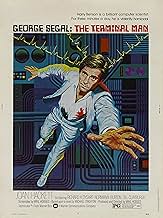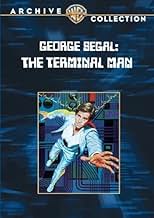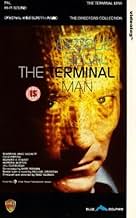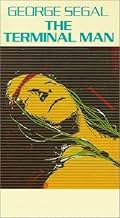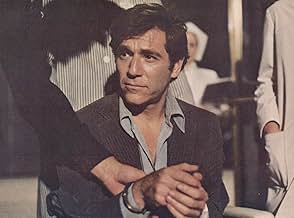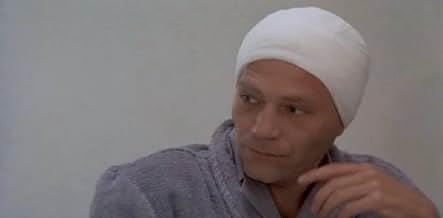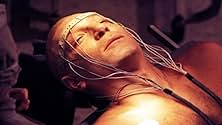Na esperança de curar seus ataques violentos, um homem concorda com uma série de microcomputadores experimentais inseridos em seu cérebro, mas inadvertidamente descobre que a violência agora... Ler tudoNa esperança de curar seus ataques violentos, um homem concorda com uma série de microcomputadores experimentais inseridos em seu cérebro, mas inadvertidamente descobre que a violência agora desencadeia uma resposta prazerosa a ele.Na esperança de curar seus ataques violentos, um homem concorda com uma série de microcomputadores experimentais inseridos em seu cérebro, mas inadvertidamente descobre que a violência agora desencadeia uma resposta prazerosa a ele.
- Direção
- Roteiristas
- Artistas
- Dr. John Ellis
- (as Richard A. Dysart)
- Det. Capt. Anders
- (as Normann Burton)
- Direção
- Roteiristas
- Elenco e equipe completos
- Produção, bilheteria e muito mais no IMDbPro
Avaliações em destaque
The likable George Segal stars as Harry Benson, a computer scientist who, since a car accident, has suffered from blackouts & seizures that made him dangerously violent. Now a team of surgeons is performing ground breaking surgery on him: attaching electrodes to 40 of his brain terminals that will hopefully counteract his violent impulses. However, as the viewer certainly suspects will happen, this doesn't work, and his brain ends up craving the shocks / stimuli that it receives, and Harry loses control once again.
I can certainly understand the problems that some people may have with this production, as it's really not the typical thriller at all. It's slow, and it's quiet; there's not even that much musical accompaniment on the soundtrack. It does exhibit a fairly cold, clinical approach, and the emphasis on the story's exposition will inevitably bore people more conditioned to non- stop action in what they watch. Even after Harry has made the expected escape from the hospital, he doesn't spend that much time running amok, and certainly does not kill very many people.
But this movie *is* noticeably intelligent and thoughtful and does offer rewards for patient viewers. It has one striking murder set piece that's rather artfully done; it takes place atop a water bed, and the sprays of water and the way the blood spreads definitely are what make the scene. And, like other movies of this kind, there is a certain wariness (voiced by Harry) on the part of mankind regarding the computer age and what it could mean for us all.
Another wonderful element to "The Terminal Man" is its incredible cast of both stars and rock solid character actors. Segal is effectively low key in the lead, and is nicely supported by Joan Hackett, Jill Clayburgh (in a small but welcome appearance), Richard Dysart, Donald Moffat, Matt Clark, Michael C. Gwynne, William Hansen, and Norman Burton. (It's particularly fun to see Dysart and Moffat sharing scenes eight years before they did John Carpenters' "The Thing" together.) And playing smaller roles are the likes of James B. Sikking, Steve Kanaly, Jack Colvin, Ian Wolfe, Lee de Broux, Victor Argo, and Nicholas Worth.
This is all reasonably engaging stuff, leading up to an ending that, while somewhat conventional, is staged in a very unique way. All in all, "The Terminal Man" is a good movie that does deserve to be discovered or rediscovered.
Seven out of 10.
I urge anyone with an IQ larger than their shoe size to ignore the negative comments and give this film a chance. Viewed with an open mind and a little patience, this movie becomes quite an exiting experience. It's one of the greatest sci-fi/horror films of all time, and has never gotten its due respect. It's the kind of film we could use more of, and the fact it's considered boring by today's audiences is very sad proof of the dumbing-down effect of Hollywood clap-trap. We're used to movies that ask you to set back while you're force-fed the story. The Terminal Man requires that you watch what's happening, listen to what's being said, and think about what's between the lines. If you can't do that, stick with Vin Diesel films.
This is a Michael Crichton book. The prolific writer has some big ideas but it often takes a good adaptation to inject a compelling narrative. This movie doesn't have it. The story is drawn-out and slow-moving. The surgery takes forever and generates little tension. The second half tries to turn into something else. By then, most people would have already lost interest. This movie may work better if it skips a lot of the surgery minutia. The story may have some social commentary to make but it's just too darn slow.
Today's audiences however, with their short attention spans, will likely be permanently disappointed. To those who complain that this film is "slow" (and they are legion); I would say to either learn some patience, or simply avoid the film and go back to watching action/adventure.
While made in the early 1970's, it is highly relevant to today's world as well. Replace the "wires in the brain" with today's over-prescribed Ritalin, SSRI's, and other similar drugs, and you will see the point.
This is an excellent movie which deserves to be on DVD, with commentary by Crichton, Hodges and/or Segal. They are all still with us as of 4/2008 (Sadly Ms. Hackett is not). The sooner the better.
Você sabia?
- CuriosidadesCrichton was fired from writing the screenplay due to the fact that his script did not follow the novel (which he had written) closely enough.
- Erros de gravaçãoAt the cemetery, the usual mechanism for lowering the coffin into the grave is missing. There aren't even any straps in place to lower it manually.
- Citações
Benson: [mumbles]
Dr. John Ellis: [operating on Benson] What was that?
Dr. Robert Morris: Patient.
Dr. John Ellis: You all right, Mr. Benson?
Benson: [groggily] Fine... fine...
Dr. John Ellis: Any pain?
Benson: No...
Dr. John Ellis: Good. Just relax now.
Benson: You too doctor...
- Versões alternativasOn its release at 2003 Edinburgh Film Festival, there was a director's cut which Hodges had cut out the beginning with the doctor looking at photographs of Harry Benson.
- ConexõesFeatured in Cinemacabre TV Trailers (1993)
- Trilhas sonorasGoldberg Variation No. 25
by Johann Sebastian Bach (as J.S. Bach)
Played by Glenn Gould
Courtesy Columbia Records
Principais escolhas
- How long is The Terminal Man?Fornecido pela Alexa
Detalhes
- Data de lançamento
- País de origem
- Idioma
- Também conhecido como
- El hombre terminal
- Locações de filme
- Empresa de produção
- Consulte mais créditos da empresa na IMDbPro
Bilheteria
- Faturamento bruto nos EUA e Canadá
- US$ 224.542
- Tempo de duração
- 1 h 44 min(104 min)
- Mixagem de som
- Proporção
- 1.85 : 1


